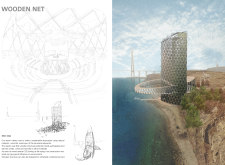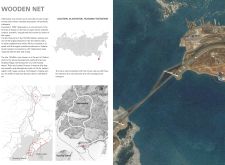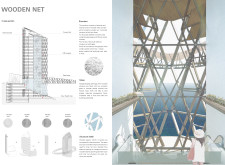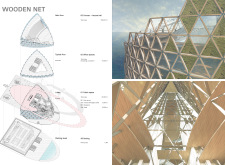5 key facts about this project
The design project located in Vladivostok showcases a modern approach to sustainable construction. Positioned near the Russkiy Bridge, the skyscraper aims to function as a multifunctional hub while drawing from the area's environmental resources. The central concept utilizes wood as the key structural material, highlighting both its strength and eco-friendliness in a bustling urban context.
Structural Design
The building features a design that incorporates both external and internal cores crafted from wooden nets. This innovative framework forms the basis of the floor slabs and enhances the overall aesthetic appeal. Concrete cores support crucial vertical elements such as staircases and elevators, which contribute to the structural stability of the skyscraper.
Materiality
A significant aspect of the design is the emphasis on material selection. Wood serves as the primary structural component, offering durability that withstands seismic forces and coastal conditions. The roof includes a bulbous wooden net, designed to blend with the environment while allowing natural light to fill the interior spaces. Glass elements further improve the connection between inside and outside, creating a bright atmosphere.
Environmental Integration
Sustainability is central to the building's exterior design. Wall treatments employ glazing and panels filled with moss, which help regulate temperature and reduce energy consumption. This choice emphasizes the building’s commitment to minimizing its environmental footprint and creates a unique look that harmonizes nature with urban life.
Interior Functionality
Inside, the skyscraper hosts a mix of uses, such as office spaces, a concert and lecture hall, and areas for public activities. The open layout is designed to promote interaction and ease of movement for occupants, enhancing its role as a community focal point in Vladivostok.
Natural elements extend to the façade, which includes triangular openings filled with low-emission glass or moss panels. These features not only contribute to sustainable energy performance but also add to the building's engaging visual character, providing an inviting presence in a vibrant urban setting.






















































